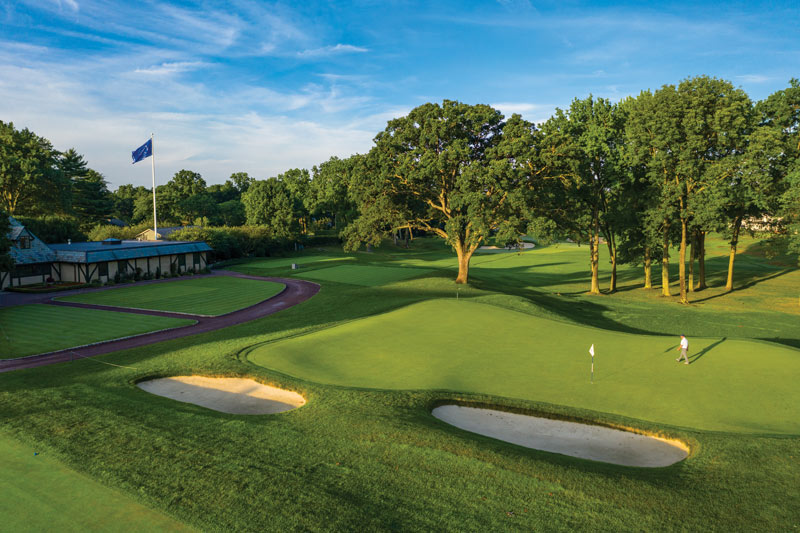
Historic Winged Foot Golf Club in Mamaroneck, N.Y., will host its sixth U.S. Open this month. Prior to pulling off the late-summer major, the golf course maintenance staff spent six years restoring all 36 holes, and weathered some monumental challenges — a global pandemic, a tropical storm — in the run-up. Photo by Larry Lambrecht
It only seems like Stephen Rabideau, CGCS, used everything but the kitchen sink to restore a golf mecca. He did, however, borrow the kitchen.
Thank goodness the clubhouse kitchen at Winged Foot Golf Club in Mamaroneck, N.Y., is near the East Course 18th green. In one encounter during a stretch in which Rabideau and his staff were toiling —
literally day and night, seven days a week, for more than half a decade — to complete an exhaustive, extensive and relentless restoration of both the East and West Course, a frozen green one night shortly before Thanksgiving presented a challenge.
“We had a huge frost. The sod, the sand, the green was frozen. It was freezing cold outside,” says West Course superintendent JR LaPan, a six-year GCSAA member. “We decided to use warm water from a hose we hooked up to the kitchen to thaw it out. We also had torches and heat lamps. It worked. It took a lot of time and effort, but we got it done.”
Well done is more like it.
“I don’t know anybody that works harder than Stephen. He and his team went at it nonstop the entire year for years. The place just came out awesome,” says Dave Staudinger, Winged Foot green chair and member since 1994.
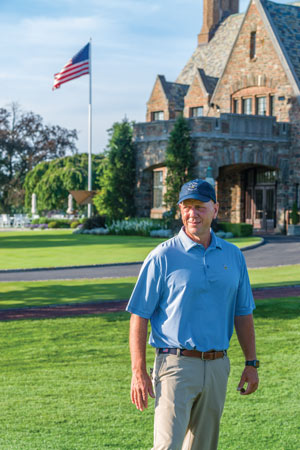
Right: Stephen Rabideau, CGCS, director of golf courses at Winged Foot Golf Club, outside the venue’s iconic clubhouse, which was designed by Clifford Charles Wendenhack. Photo by Larry Lambrecht
When the rescheduled U.S. Open begins Sept. 17 at Winged Foot’s West Course, it will mark the sixth U.S. Open championship on that layout. The 36-hole, two-course restoration is a nod to famed designer A.W. Tillinghast, who created Winged Foot nearly 100 years ago. When the world’s best players tee it up, the West Course will more closely resemble its appearance when Bobby Jones won the U.S. Open in 1929 than when Phil Mickelson probably should have won it the last time it was held at Winged Foot in 2006.
The COVID-19 pandemic is why the U.S. Open wasn’t held in its traditional June time slot. That meant the world had to wait a little while longer to see what Rabideau and crew accomplished, sometimes cranking it out in the snow, to restore Winged Foot’s charm from a bygone era. “For us, it’s something we’ve been working toward since we found out in 2013 we were having this,” says Rabideau, director of golf courses and a 26-year GCSAA member. “It’s everything we’ve been doing. Everything.”
A sensational stretch
Winged Foot made the 20th century chic again.
“They wanted traditional. It looks fantastic,” says Darin Bevard, director of championship agronomy for the USGA.
The process was launched in fall 2013 and lasted until spring 2018. Architect Gil Hanse (who had redesigned a practice facility at Winged Foot in 2012) used old photographs as a guide to restore every tee, green and bunker to their original dimensions, akin to how Winged Foot presented itself when golf was first played there in 1923.
Hanse, along with LaBar Golf construction company, joined forces with Rabideau to spearhead the mammoth project. Their efforts began with opening 10 holes on the East Course in fall 2013, work that concluded the following spring. They tackled the remaining eight holes beginning in fall 2014 and finished in spring 2015. (In 2016, the East Course, which has hosted two U.S. Women’s Opens and a U.S. Senior Open, hosted the U.S. Amateur Four-Ball.)
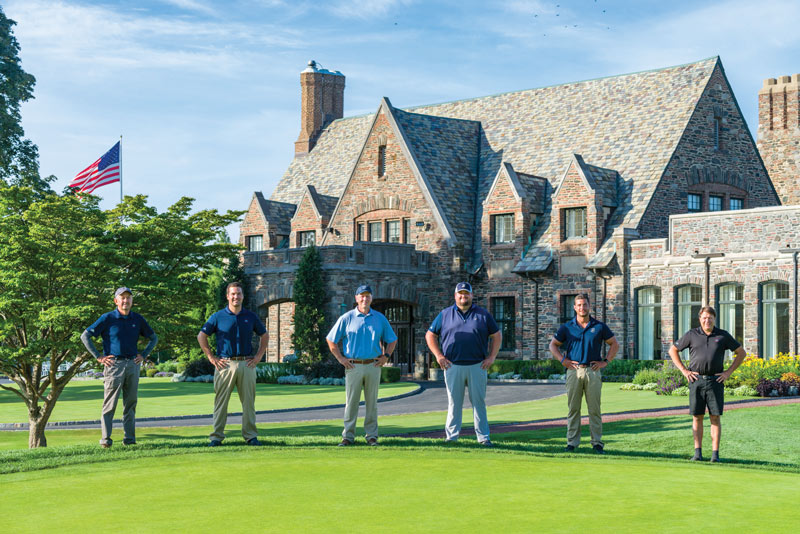
The Winged Foot Golf Club senior management turf maintenance team, from left: irrigation technician Manny Tejada; East Course superintendent Steven Bigelow; director of golf courses Stephen Rabideau, CGCS; U.S. Open superintendent Weston Neff; West Course superintendent JR LaPan; and equipment technician John Yursa. Photo by Larry Lambrecht
A West Course restoration was not on the club’s radar — until club members got a taste of the restored East Course.
“We rebuilt and expanded the greens and changed the infrastructure of them to USGA guidelines, in part by using Robotic Total Stations (automated technology that swiftly calculates and inspects). Our goal was to put them back exactly the same,” Rabideau says, “and once the members came out and played it, they were sold on it, and they wanted to do the West. The work we did on the East sold the West project.”
Editor’s note: Just a month shy of the 2020 U.S. Open, Winged Foot Golf Club was hit with tree loss and a prolonged power outage courtesy of Tropical Storm Isaias. Read more and see photos of the aftermath in Damage done at Winged Foot Golf Club.
The East Course restoration was a perfect dress rehearsal. West Course restoration was initiated in fall 2016 with work on the back nine holes and lasted until spring 2017. The front-nine project began in fall 2017 and ended the next spring in time for play to commence in May 2018, completing a job in which a master drainage plan was implemented, with 40 miles of drainage pipe installed to cover both courses.
“With each phase, beginning on the East Course, we tried to get better,” Rabideau says. “Once we finished the first phase, we said, ‘Let’s try and do this better.’ When we knew we had the Open; we tried to make sure we got better at everything. Not that we did a bad job on the East, because the East is great. But it was the little things. I tell people basically we practiced and honed our skills on the East and tried to perfect it on the West.
“I think we did a better job at sod work on the greens and just got better at attention to detail. We grew our own sod in-house, so we got better at making nurseries. When we were doing the West, we were flipping 100,000 square feet of nursery sod each season. We made our own grass for green expansions, tee expansions, and fairway expansions. We took all our topsoil, all the native push-up mix we took out of the greens, and we ended up stripping and using that around all the bunkers and green surrounds, so we’d strip all the thatch off that and we’d just coat everything with good green soils. We were not on the sideline of this project at all. We were active.”
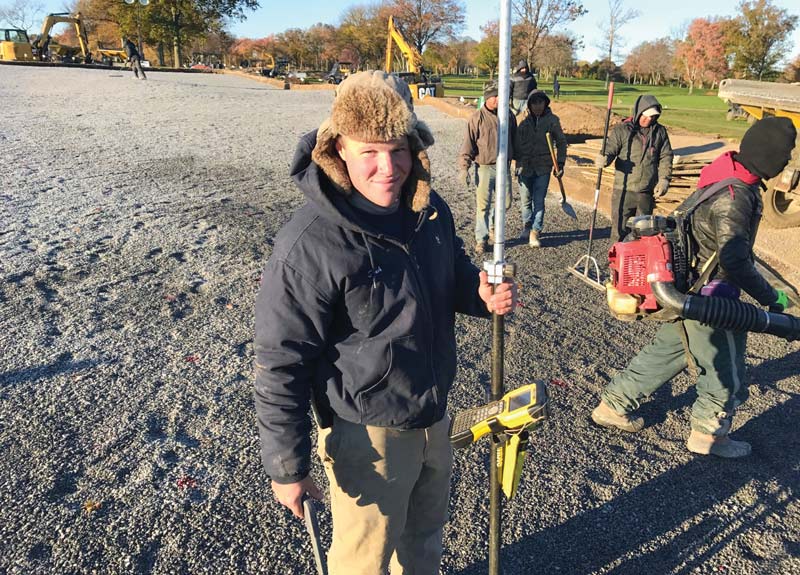
Assistant superintendent Mark Brodd, surveying rod/data collector in hand, uses the Total Robotic Station to install a gravel layer.
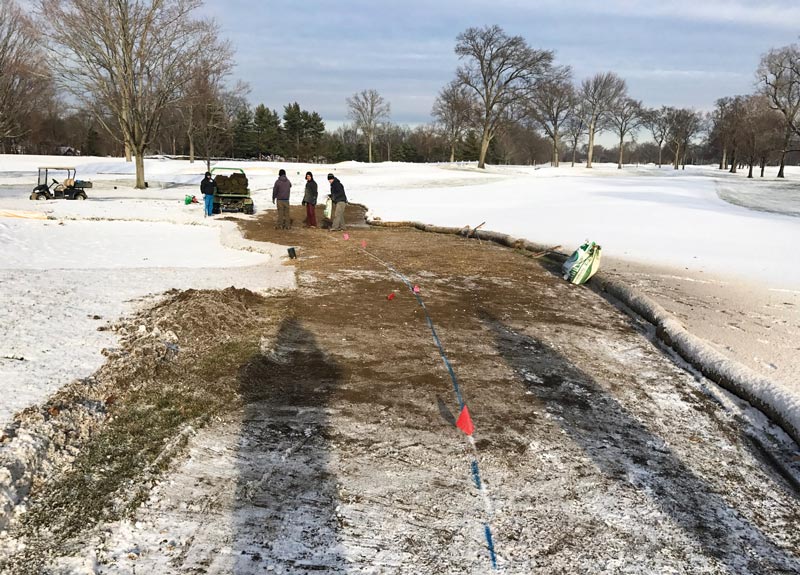
Sodding a fairway expansion on the 18th hole of the West Course on a January day, a task that first required blowing off snow. Photos courtesy of Stephen Rabideau
And the focus never changed. “We didn’t do the West Course for the Open. Every day, our goal was the same — to do it for the members,” Rabideau says. “We were hoping people didn’t notice things when we were done because that meant we did our job. We really weren’t trying to change anything. And it was an added benefit that we were holding the Open.”
Winged Foot U.S. Open superintendent Weston Neff earned an associate degree and a bachelor’s degree from the University of Massachusetts. He never imagined, though, that he would get schooled to this extent. Neff, an 11-year GCSAA member who arrived at Winged Foot in 2012 when both he and Rabideau came from Wheatley Hills Golf Club in East Williston, N.Y., says, “Since I got here, I learned I could do a lot more things than I thought I could do. I think all of us learned that. We all learned how to do green scans and GPS. We were able to learn how to do things ourselves. We didn’t need to bring someone in and guide them around and do it for us.”
The restoration outcome is no surprise to Rabideau’s peer and friend Craig Currier. Regional golf course superintendent at Glen Oaks Country Club in Old Westbury, N.Y., and superintendent at Bethpage Black Golf Course in Farmingdale, N.Y., for the U.S. Open in 2002 and 2009, Currier expected Rabideau to produce something special.
“He put his heart and soul into that thing. I’ve never seen a guy with more passion about something. The guy just doesn’t stop,” says Currier, a 29-year GCSAA Class A member. “He’s got an army up there, working sunup to sundown. That place is like a machine.”
Well-oiled and highly motivated, obviously. “Every day is the U.S. Open to us,” Neff says. “We grind to put the conditions out there.”
What’s old is new
Winged Foot has an old-school look and feel now, but it has been modernized in ways that benefit maintenance.
Poa annua greens are larger (25,000 feet more on the West Course) and mirror those built by Tillinghast, which were more rectangular than round all those years ago but lost their shape over time. “We brought it into the 21st century by taking greens that were built in the early 1920s to, at that time, hold moisture,” says Rabideau, whose first experience at Winged Foot came in 1997 as a volunteer for the PGA Championship while he was an assistant at The Seawane Club in Hewlett Harbor, N.Y. “Moisture is not our friend anymore. We don’t want to hold moisture now. We changed the infrastructure with the USGA mix, SubAir technology and Better Billy Bunker for improved drainage. We’re ready to rock and roll.”
Bevard says the entire operation is rock steady at Winged Foot, where the West Course has also hosted a PGA Championship, two U.S. Amateurs and a Walker Cup, and will play at more than 7,400 yards and par 70 for the U.S. Open.
“These greens are great. What they have done here guaranteed success, plus you have one of the best superintendents in the country,” says Bevard, noting that the restoration has enhanced options for new hole locations that didn’t exist in 2006 (Nos. 1, 3, 10, 11, 12, 13 and 15). “On No. 17, we’ll have a hole location that was rough in 2006.”
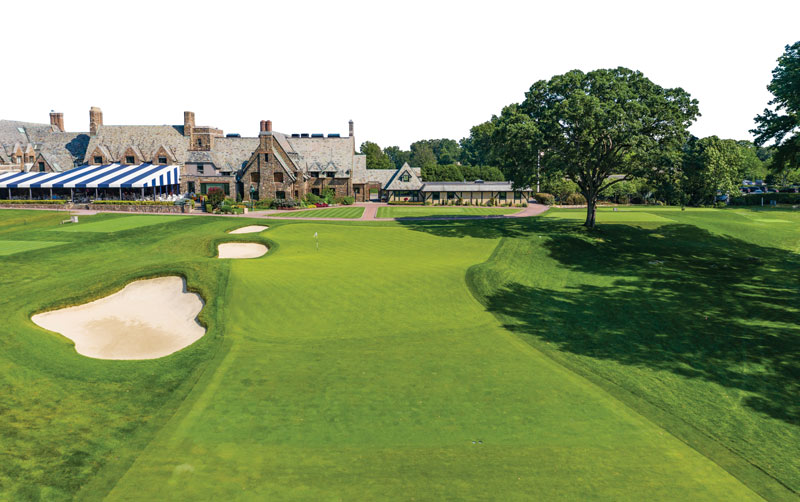
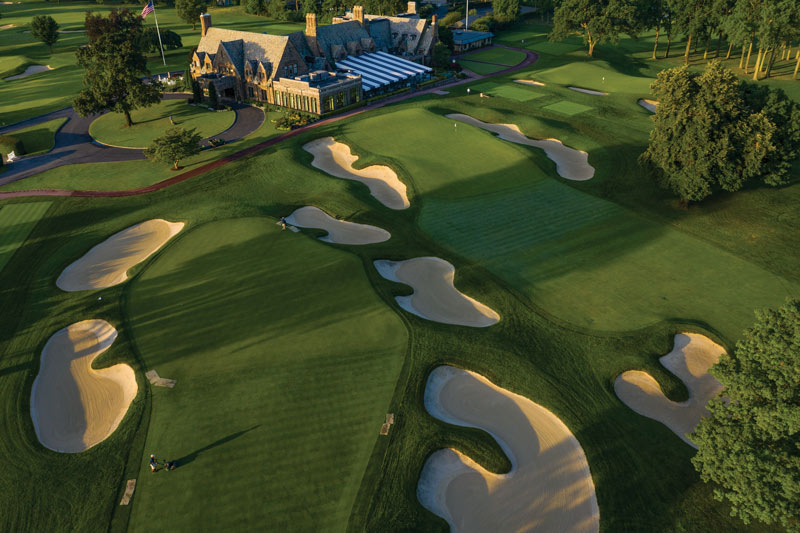
Photos by Larry Lambrecht
The West Course still has its trademark narrow, tree-lined fairways. In response to an uptick in equipment technology, some bunkers were relocated farther from the tee.
Juicy rough (a combination of bluegrass, ryegrass and Poa annua) has posed the most critical task for Rabideau given the adjusted championship date. Surviving the summer unscathed called for a plan alteration.
“Once we knew the Open was switched, we had to take a deep breath and refocus and keep the place pristine through the summer,” Rabideau says. “There’s a different plan for rough in summertime — a much different plan. You’re watering, and that brings on diseases like summer patch, gray leaf spot, Pythium — something we don’t typically treat for at that time. So the focus was on the rough, keeping it good and healthy all summer long, which is hard. I mean, the U.S. Open is in June for a reason.”
Light and day
Here’s hoping for no cloudy mornings.
Sunrise for the opening round of the U.S. Open is 6:38 a.m. — only 12 minutes prior to the first tee time Thursday. The difference in available light in September compared with what it would’ve been in June is immense. Rabideau estimates his crew will lose about two hours of daylight. “We’re going to be working in the dark. We’ll have lights everywhere, light towers, portable lights. Headlamps on when everybody is working. It’s new to everybody,” he says, “but one thing that makes superintendents good is the ability to call an audible and make changes on the fly, and I think that’s what we’re going to have to do a lot that week.”
Face it: 2020 really is new to everybody. And it’s not over yet. Rabideau is on guard for anything else that could happen at Winged Foot, where the West Course is scheduled to close for play immediately after Labor Day as it awaits the U.S. Open, which will be staged without fans because of the pandemic.
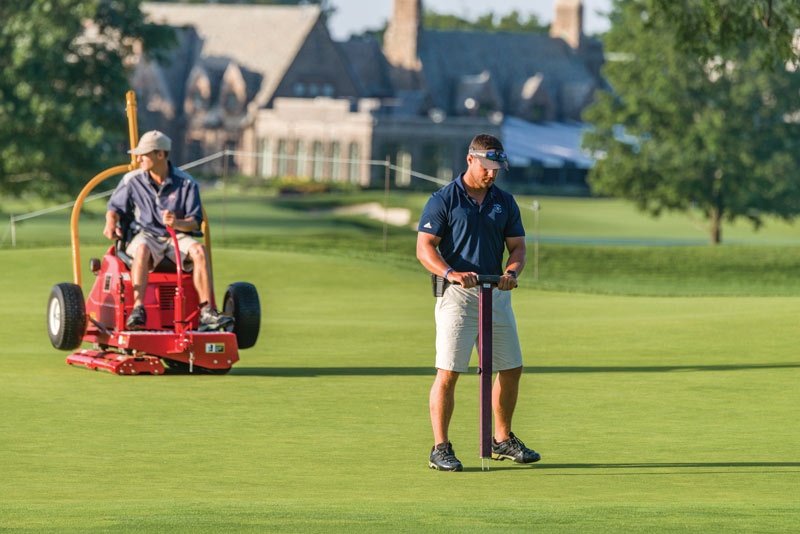
The ninth green on Winged Foot’s West Course gets some attention from assistant superintendent Kevin Crill, who is rolling the green, and West Course superintendent JR LaPan, who is taking moisture readings.
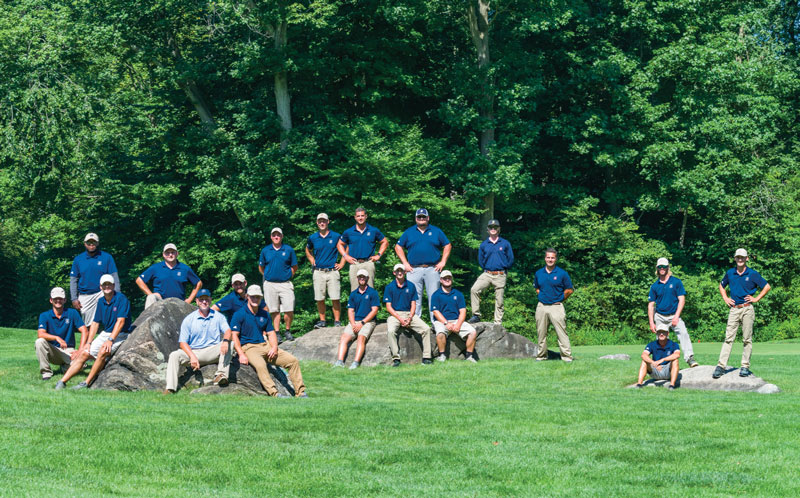
The 2020 Winged Foot turf team, including senior management, assistant superintendents, assistants-in-training and interns. Photos by Larry Lambrecht
“Typically, it (September) is a dry month. But I’m worried about tropical storms this year (the facility already encountered one; see Damage done at Winged Foot Golf Club). Everything we’re hearing is it’s going to be a more active year, so it probably would be fitting that this year, with COVID, that we’d get a tropical storm the week of the Open,” he says. “I mean, why wouldn’t we?”
Let’s hope not. And, during a month when sports is normally more about the NFL than pro golf, Rabideau compares what is about to play out at Winged Foot — which, in 2019, earned U.S. National Register of Historic Places recognition — to a rather large game on the gridiron. “Listen, for a superintendent, I think the U.S. Open’s probably our Super Bowl, right? When you get to be the host club for a U.S. Open, it’s awesome,” Rabideau says, “and the buy-in from our team to accomplish what we have done to make it possible was off the charts.”
Hot chocolate, anyone?
A blanket of snow at Winged Foot? No problem. Maintenance crew members had it covered. They proved neither rain nor sleet nor snow mattered.
All-day work marathons that continued whether it was spring, fall or winter forged even greater ties among the team led by Stephen Rabideau, CGCS. “The dedication from our crew, Gil’s (Hanse, course restoration architect) team and the construction team stands out to me, working under the lights until 8 or 9 at night,” Rabideau says. “There was a lot of sacrifice and dedication to get this done in a short amount of time.

Under the lights: Night work striking the greens off on the West Course’s second hole. From 2013 to 2018, the crew at Winged Foot worked from early morning to after sundown to restore both the East and West courses. Photo courtesy of Stephen Rabideau
“As the project got later in the year and it got dark earlier, October wasn’t bad. When it got to November and December, we were blowing snow off areas and sodding fairways and building bunkers in snow. It didn’t matter. We rebuilt every bunker, every green, every tee. Fairway grass lines changed. We flipped fairway lines. We’d go out and flag drainage and do drainage and put in pipe in snow. We had to keep moving forward, basically seven days a week.”
Once, on an extremely frigid night, Rabideau had hoped to warm his crew that was working under portable lights by serving them hot chocolate.
“We’re doing irrigation around a green,” recalls Winged Foot U.S. Open superintendent Weston Neff, “and he has 25 hot chocolates in this big tray. As he walks toward us, he steps into a trench, started to fall down and, somehow, nothing spilled.”
Those memories — even Rabideau’s nice save on those much-appreciated hot chocolates — are precious to East Course superintendent Steven Bigelow. “I didn’t anticipate the amount of hours and what can be done in December,” Bigelow says. “We have a brotherhood and did this together.”
Howard Richman is GCM’s associate editor.